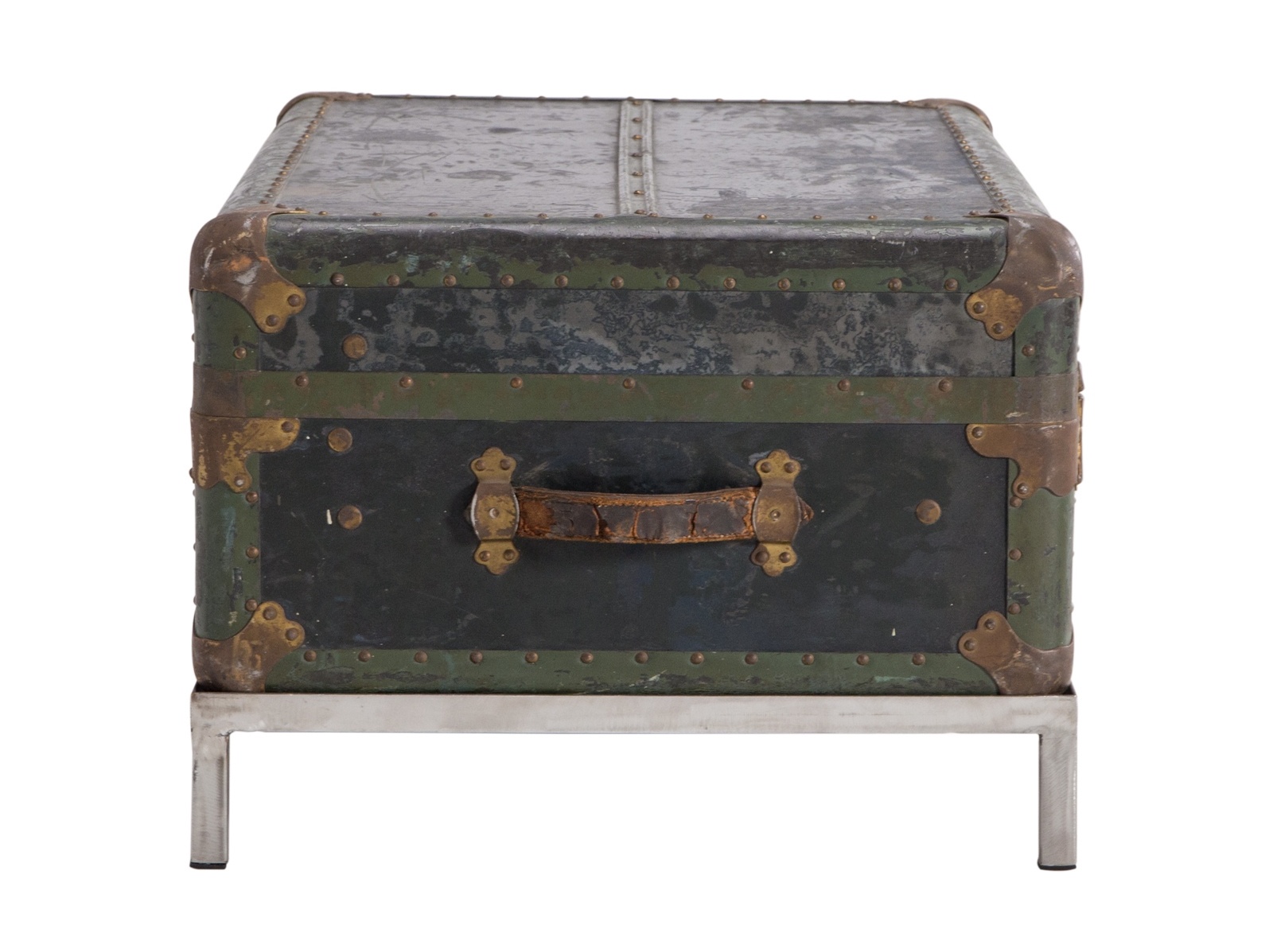
The luxury steamer trunk has long been a nostalgic symbol of a bygone era. It conjures images of fashionably attired travelers with bustled dresses and stylish jaunty hats boarding great steamships destined for faraway ports; or elegant transcontinental trains, disgorging plumes of smoke as they rush toward foreign cities, unveiling spectacular vistas around each new bend in the track. Such is the emotional impact these magnificent trunks can have on us. Covered in embossed canvas or leather, festooned with glinting hardware that appears to serve no discernible purpose other than to draw the eye, these unwieldy pieces of luggage may have fallen from favor, another casualty of modern travel. However, they still somehow manage to capture our imagination and subtly remind us of a life well-lived.
It should be no surprise then that these over-sized suitcases have experienced a resurgence in recent years. We find them in antique and vintage shops around the globe, in ever increasing number, where collectors are willing to put down hefty sums for a chance to own one. Yet curiously, their use no longer seems to involve travel. They have instead found a new purpose; a second chance, if you will, though one that is still linked to a glamorous past.
Nowadays, we more commonly find them serving as decorative items in the home – something which has become a burgeoning trend in interior design. And by cleverly inserting them into a design, the designer is able to evoke a timeless sense of nostalgia within the space they create.
The history of the steamer trunk stretches back to the mid-18th Century. They were designed for the purpose of transporting mail, and were commonly seen strapped to the back of postal carriages. The original models had a sloped, camelback lid that would allow rainwater to easily run off, keeping exterior dry and their contents protected. In the 19th Century, as recreational travel became more common among the upper-middle class, the trunks were adapted for personal use: to transport clothing, toiletries, and even books. Consequently their design underwent several distinct changes – most notably, the flat lid. As trunks were now being stored in luggage compartments aboard trains and steamships rather than in back of carriages (which is how they eventually earned their name), a flat lid made more practical sense since it allowed the trunks to be stacked. When you consider that the average family of four would typically travel with no fewer that twelve trunks on any given passage, this was a far more efficient use of limited space.

The luxury steamer trunk also adopted some decorative elements that quickly became indicators of a traveler’s wealth and status. Embossed logos, which identified pricier brands such as the familiar LV pattern of Luis Vuitton, were applied to a canvas exterior, replacing the former metal and leather frames as they were lighter, dried quickly, and were easier to clean.
Additional steps were taken to enhance the trunks’ attractiveness and to endow them as indicators of one’s status – something that would never have been considered a century earlier. The trunks were embellished with brass hardware that was buffed and polished until it shone like gold. For marketing reasons, these adornments became known as “the jewelry.” Some familiar examples of this hardware are the ornate locks, clasps, brackets, rivets, and rounded corner pieces, which protected the barrel from violent jolting on trains and long sea voyages.
There were numerous manufacturers of luxury steamer trunks at the time, both here in the States and in Europe. Of these, however, the French manufactures were the most wildly coveted and still remain so today. The three most prominent among them were Goyard, Moynat Paris and, of course, the incomparable Louis Vuitton. All the same, many of our domestic brands (such as Lavolaille, Hartmann, and Oshkosh) were equally popular, particularly among the American tourists.
The luxury steamer trunk soon adopted more decorative elements that became indicators of a traveler’s wealth and status.
Refurbishing these vintage trunks has become something of a cottage industry. One noteworthy company that specializes in their restoration is Rêve de Bagages, located in Haguenau, France. We recommend checking out their website at La malle en coin. The site offers an impressive inventory of vintage trunks, targeted at the discriminating collector. And for those will a real interest, you can also find a selection of videos on the site that demonstrate the painstaking process by which these magnificent pieces are restored – everything from re-framing the balsam slats, to buffing and replacing the original hardware, to re-lining the interiors with matching silk fabrics. No doubt, it is an impassioned labor of love for these talented craftsmen.
 We can attribute the current repurposing of the steamer trunk, in all of its myriad forms and functions, in large part to the vision of those interior designers who include then in their design schemes. While these pieces are undoubtedly beautiful in and of themselves, it’s the associations they may conjure that add most to their allure.
We can attribute the current repurposing of the steamer trunk, in all of its myriad forms and functions, in large part to the vision of those interior designers who include then in their design schemes. While these pieces are undoubtedly beautiful in and of themselves, it’s the associations they may conjure that add most to their allure.
Introducing a trunk in the décor of a room, particularly one with an exotic theme, can touch upon our subliminal yearning for adventure and travel, and add a whimsical element to an otherwise prosaic space.
The challenge, of course, is to incorporate the pieces in ways that are unexpected, while still making practical sense. We often find them functioning as a coffee or side table, which can be a quite effective and visually impactful use in a living room. Some designers will take this a step further by mounting the trunk on a custom stand, made of wood or iron. This not only provides support, but closes that seeming gap between furniture and luggage. Verve Design took this same approach on a unique project where a narrow cabin trunk was tucked neatly beneath a display table to suggest a small bench (see adjacent photo). This adaptation could further be enhanced with the addition of a custom-made cushion covered in a vibrant accent fabric.
A common spot for a steamer trunk is at the foot of a bed. When placed here, it not only serves as a convenient bench, but does double-duty by providing a place to store additional bedding and blankets. Once again, style and form can work together in the application of these versatile pieces.
 If there is one trunk design that stand out among the lot, it is likely the library trunk. These beautiful pieces were very popular in the latter half of the 19th Century. They not only provided travelers with a ready means to transport their books, they also doubled as makeshift desks, built with a drop-down panel for writing and a number of small compartments where ink, pens, stamps, and stationery could be stored – similar to what you’d find on a secretary. In a time prior to televisions or electronic devices, where entertaining oneself is a relatively easy feat, owning a trunk such as this was a boon luxury, if not a necessity, on those lengthy transatlantic journeys.
If there is one trunk design that stand out among the lot, it is likely the library trunk. These beautiful pieces were very popular in the latter half of the 19th Century. They not only provided travelers with a ready means to transport their books, they also doubled as makeshift desks, built with a drop-down panel for writing and a number of small compartments where ink, pens, stamps, and stationery could be stored – similar to what you’d find on a secretary. In a time prior to televisions or electronic devices, where entertaining oneself is a relatively easy feat, owning a trunk such as this was a boon luxury, if not a necessity, on those lengthy transatlantic journeys.
Despite their popularity, finding a library trunk today can be a challenging task. If you are indeed fortunate enough to track one done, a trunk like this, when propped up and opened in an empty corner of a room, can be a fantastic way to create an intimate writing nook and add a novel element to an otherwise unused space.
A similar effect may be achieved with yet another popular trunk style. The wardrobe trunk was the largest and, perhaps, most popular of commercially manufactured trunks. It typically comes with a full row of drawers on one side, for folded clothing, and a hollow compartment on the opposing that’s fitted with a rod for hanging either dresses or shirts. Used in a bedroom, it provides a creative alternative to a large and bulky wardrobe, which can too often upsets the balance of a room.
Another innovative way to work these trunks into a room’s design is to stack a few hat trunks — the smallest of the trunk varieties). In doing so, you create a makeshift stand for a vase, a plant, or even a piece of sculpture.
There are clearly endless ways in which these beautiful pieces can serve the design of a room. Their creative use is only bound by the limits of one’s imagination. In the end, however, what seems to appeal the most about them, apart from any nostalgic notions they may inspire, is the idea that something old can suddenly be made new again — and not in a way that its creator had ever intended. While these trunks continue to possess the same elegance, the same artistry, that any exceptional pierce of craftsmanship does, they now answer a different call. Yet, one that continues to inspire and delight. They have evolved, as all things must. And in a world where the obsolete is too often discarded for what is new and relevant, it’s refreshing to find that something from the past, made with such care and refinement, can adopt new meaning in the beauty of our homes.






Jim
| 18 October 2021This is a wonderfully written article that not only educates but entertains on a topic that is absolutely fascinating: steamer trunks! Well done!